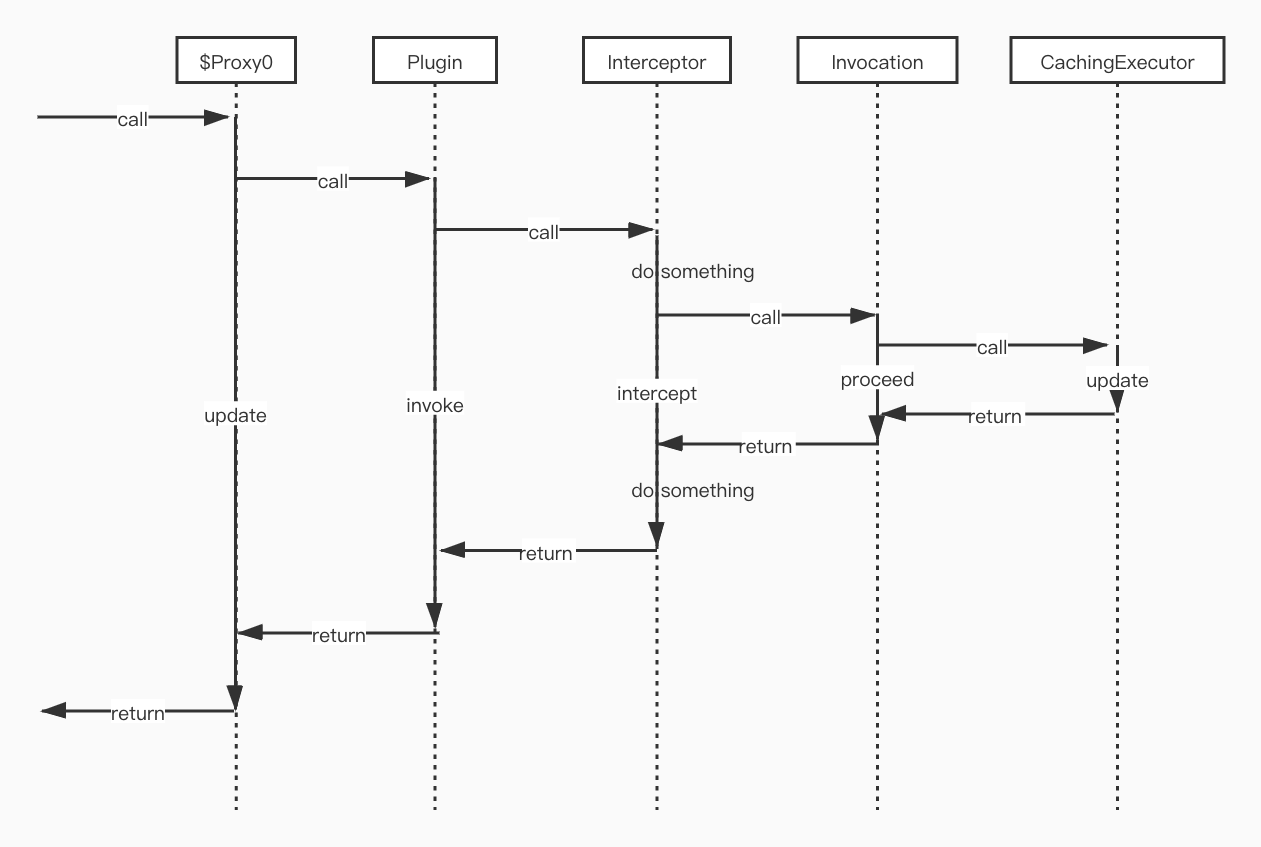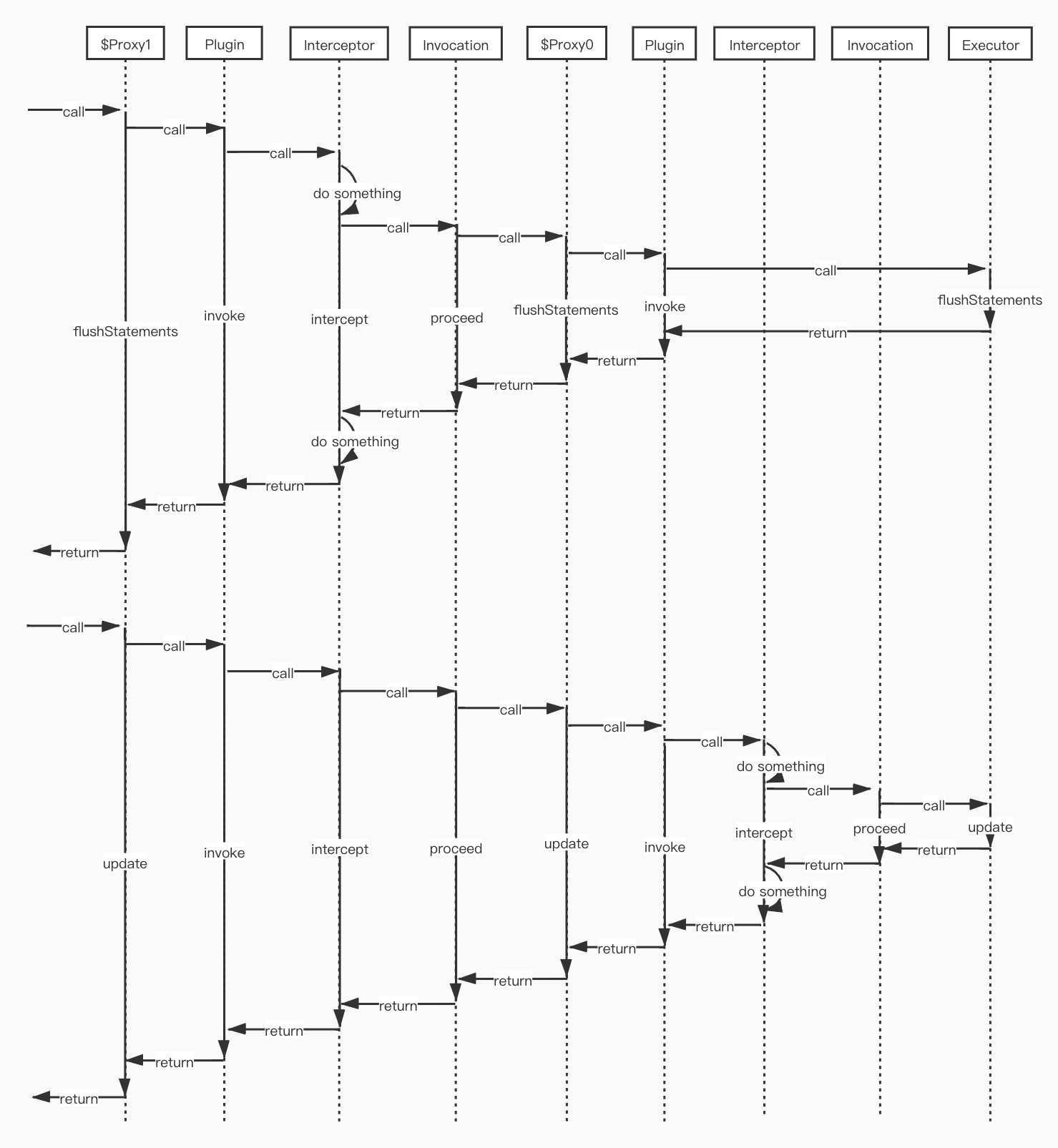Mybatis插件实现原理
本文如有任何纰漏、错误,请不吝指出,谢谢!
首先,我并没有使用过 Mybatis的插件,但是这个和我写这篇文章并不冲突,估计能真正使用到插件的人也比较少,写这篇文章的目的主要是看源码时稍微看到了下它的插件实现,发现还挺绕的,于是就特意琢磨了下,然后留了一个记录。
mybatis中的插件,也就是拦截器interceptor,也挺有意思的。
它的简单使用,就直接拿文档中的示例来简单说下
使用
使用方式很简单
// 使用这个注解,表明这是一个拦截器
@Intercepts(
// 方法签名
{@Signature(
// 被拦截方法所在的类
type= Executor.class,
// 被拦截方法名
method = "update",
// 被拦截方法参数列表类型
args = {MappedStatement.class ,Object.class})}
)
public class ExamplePlugin implements Interceptor {
// 拦截时具体行为
@Override
public Object intercept(Invocation invocation) throws Throwable {
// implement pre-processing if needed
Object returnObject = invocation.proceed();
// implement post-processing if needed
return returnObject;
}
}
然后如果是xml配置的话
<plugins>
<plugin interceptor="org.mybatis.example.ExamplePlugin">
<property name="someProperty" value="100"/>
</plugin>
</plugins>
如果是 SpringBoot的话,应该是配合自动配置使用,将上面的类使用@Component注解,交由Spring容器管理,然后注册到mybatis的InterceptorChain
mybaits目前支持拦截的类和方法,有下面这些
- Executor (update, query, flushStatements, commit, rollback, getTransaction, close, isClosed)
- StatementHandler (prepare, parameterize, batch, update, query)
- ParameterHandler (getParameterObject, setParameters)
- ResultsetHandle (handleResultSets, handleOutputParameters)
实现原理
有可能从上面的使用猜出来它的拦截器的实现原理,那就是动态代理的方式,只不过 mybatis这里并不是很直接的来使用代理,绕了个弯,于是给人感觉特别晕,也说不好这个实现是不是有些问题
就先从Executor说起吧
我们从SqlSessionFactory获取一个SqlSession时,会创建一个新的Executor实例,这个实际的创建动作在这里
org.apache.ibatis.session.Configuration#newExecutor
public Executor newExecutor(Transaction transaction, ExecutorType executorType) {
// 根据设置的执行器类型,创建相应类型的执行器
executorType = executorType == null ? defaultExecutorType : executorType;
executorType = executorType == null ? ExecutorType.SIMPLE : executorType;
Executor executor;
if (ExecutorType.BATCH == executorType) {
executor = new BatchExecutor(this, transaction);
} else if (ExecutorType.REUSE == executorType) {
executor = new ReuseExecutor(this, transaction);
} else {
executor = new SimpleExecutor(this, transaction);
}
// 如果开启了缓存,使用缓存,这里缓存执行器有点类似静态代理了
if (cacheEnabled) {
executor = new CachingExecutor(executor);
}
// 将原始执行器对象,包装下,生成一个新的执行器,代理后的对象
executor = (Executor) interceptorChain.pluginAll(executor);
return executor;
}
InterceptorChain是一个管家,有点类似于FilterChain,但是注意,其实差别非常的大
public class InterceptorChain {
// 所有拦截器列表
private final List<Interceptor> interceptors = new ArrayList<>();
// 这里可能会是层层代理对象,一套又一套的,具体取决于拦截器的个数和被拦截的
// 方法所在的类
// 配置的拦截器数和每一次代理对象生成次数并不相同,会小于等于拦截器的个数
public Object pluginAll(Object target) {
for (Interceptor interceptor : interceptors) {
target = interceptor.plugin(target);
}
// 返回最后一次创建的代理对象
return target;
}
// 注册拦截器的
public void addInterceptor(Interceptor interceptor) {
interceptors.add(interceptor);
}
}
Interceptor是一个接口,也就是mybatis直接暴露给用户使用的需要用户实现的拦截器接口
public interface Interceptor {
// 实现类填充自己的逻辑,参数为Invocation,
Object intercept(Invocation invocation) throws Throwable;
// 默认方法,创建代理对象
default Object plugin(Object target) {
return Plugin.wrap(target, this);
}
// 实现类去做些事情
default void setProperties(Properties properties) {
// NOP
}
}
着重看下一这个
// 首先这是一个Jdk动态代理的InvocationHandler实现类
public class Plugin implements InvocationHandler {
private final Object target;
private final Interceptor interceptor;
private final Map<Class<?>, Set<Method>> signatureMap;
private Plugin(Object target, Interceptor interceptor, Map<Class<?>, Set<Method>> signatureMap) {
this.target = target;
this.interceptor = interceptor;
this.signatureMap = signatureMap;
}
// 静态方法,用来直接创建代理对象
public static Object wrap(Object target, Interceptor interceptor) {
// 获取当前拦截器需要被拦截的所有的方法
Map<Class<?>, Set<Method>> signatureMap = getSignatureMap(interceptor);
// 获取被代理对象的Class
Class<?> type = target.getClass();
// 把被代理对象所有能在签名Map中找到的直接实现的接口和祖先接口,查找出来
Class<?>[] interfaces = getAllInterfaces(type, signatureMap);
// 找到了就创建代理对象
if (interfaces.length > 0) {
return Proxy.newProxyInstance(
type.getClassLoader(),
interfaces,
// 创建一个InvocationHandler实例
new Plugin(target, interceptor, signatureMap));
}
// 没找到 就返回
// 这个对象不一定说一个未经代理过的对象,也可能是代理过的
return target;
}
// 当调用这个代理对象的任何方法时,调用此方法
@Override
public Object invoke(Object proxy, Method method, Object[] args) throws Throwable {
try {
// 首先找下当前被调用的这个方法所在的类,被拦截的所有的方法
Set<Method> methods = signatureMap.get(method.getDeclaringClass());
if (methods != null && methods.contains(method)) {
// 如果当前被调用的方法是需要被拦截的,那么就执行我们自定义的拦截逻辑
// interceptor是我们自定义的拦截器,在我们自定义的拦截器里,需要获取到
// 原委托对象,被调用的方法,以及参数,这里做了很好的封装,将用户的使用和
// 具体的实现,做了一个完全的分离,用户感知不到任何具体的实现
// Invocation#proceed 就做了一件事 method.invoke(target,args);
return interceptor.intercept(new Invocation(target, method, args));
}
// 如果当前被调用的方法没有被拦截,那么直接调用原方法
return method.invoke(target, args);
} catch (Exception e) {
throw ExceptionUtil.unwrapThrowable(e);
}
}
// 获取拦截器指定的被拦截方法的方法签名
// key是被拦截方法的返回值类型
private static Map<Class<?>, Set<Method>> getSignatureMap(Interceptor interceptor) {
// 获取注解 @Intercepts信息
Intercepts interceptsAnnotation = interceptor.getClass().getAnnotation(Intercepts.class);
// issue #251 避免出现没有具体的拦截信息的情况
if (interceptsAnnotation == null) {
throw new PluginException("No @Intercepts annotation was found in interceptor " + interceptor.getClass().getName());
}
// 获取配置的被拦截方法的签名信息
Signature[] sigs = interceptsAnnotation.value();
Map<Class<?>, Set<Method>> signatureMap = new HashMap<>();
// 统统放到Map
for (Signature sig : sigs) {
Set<Method> methods = signatureMap.computeIfAbsent(sig.type(), k -> new HashSet<>());
try {
// 将定义构建成实际的Method对象
Method method = sig.type().getMethod(sig.method(), sig.args());
methods.add(method);
} catch (NoSuchMethodException e) {
throw new PluginException("Could not find method on " + sig.type() + " named " + sig.method() + ". Cause: " + e, e);
}
}
return signatureMap;
}
// 获取被代理对象所有的接口信息
private static Class<?>[] getAllInterfaces(Class<?> type, Map<Class<?>, Set<Method>> signatureMap) {
Set<Class<?>> interfaces = new HashSet<>();
while (type != null) {
for (Class<?> c : type.getInterfaces()) {
if (signatureMap.containsKey(c)) {
// 如果被代理类接口和返回值类型一致,接口加进来
interfaces.add(c);
}
}
// 找到被代理类的父类,然后继续查找接口信息
type = type.getSuperclass();
}
return interfaces.toArray(new Class<?>[interfaces.size()]);
}
}
到这里就说完了mybatis插件的实现原理
整体实现其实也很简单,我们想给那个类的哪个方法拦截一下,把实现拦截器,然后配置下要拦截的信息,之后mybatis给我们生成一个动态代理对象,就可以了。
下面我们以具体案例来更加深刻的认识理解其实现原理
加强理解
我们使用具体的案例,来走一遍
Case 1
单拦截器单拦截方法
@Intercepts(
{@Signature(
type= Executor.class,
method = "update",
args = {MappedStatement.class ,Object.class})}
)
public class ExamplePlugin implements Interceptor {
@Override
public Object intercept(Invocation invocation) throws Throwable {
System.out.println("before execute update");
Object returnObject = invocation.proceed();
System.out.println("after execute update");
return returnObject;
}
}
假设目前我们就设置了这么一个拦截器
那么就会生成一个CachingExecutor的代理对象,我们假设代理对象的全限定名是com.sun.proxy.$Proxy0,并且这个对象对象是implements Executor的
这时调用代理对象的update方法调用栈如下

Case 2
单拦截器多拦截方法
假设有个需求需要给StatementHandler的update增加点一样的拦截逻辑
@Intercepts(
{@Signature(
type= Executor.class,
method = "update",
args = {MappedStatement.class ,Object.class})},
{@Signature(
type= StatementHandler.class,
method = "update",
args = {Statement.class})}
)
public class ExamplePlugin implements Interceptor {
@Override
public Object intercept(Invocation invocation) throws Throwable {
System.out.println("before execute update");
Object returnObject = invocation.proceed();
System.out.println("after execute update");
return returnObject;
}
}
同样是获取执行器的逻辑,这个时候我们得到的代理后的对象不会是同时实现了Executor 和StatementHandler接口的,只能实现Executor接口,因为这个
// 这个时候type为 CachingExecutor
private static Class<?>[] getAllInterfaces(Class<?> type, Map<Class<?>, Set<Method>> signatureMap) {
Set<Class<?>> interfaces = new HashSet<>();
while (type != null) {
// type的接口Executor显然是在Map中的
for (Class<?> c : type.getInterfaces()) {
// 仅允许对接口为Executor的实例做代理,因为代理后的类一定得是一个Executor的实现类
if (signatureMap.containsKey(c)) {
interfaces.add(c);
}
}
type = type.getSuperclass();
}
// 最终也就只能找到Executor这么一个接口了
return interfaces.toArray(new Class<?>[interfaces.size()]);
}
这种情况下就和上面一样了
区别在于,如果我们需要创建一个StatementHandler的实例时,代理对象就会变成StatementHandler的实现类实例了
public StatementHandler newStatementHandler(Executor executor, MappedStatement mappedStatement, Object parameterObject, RowBounds rowBounds, ResultHandler resultHandler, BoundSql boundSql) {
StatementHandler statementHandler = new RoutingStatementHandler(executor, mappedStatement, parameterObject, rowBounds, resultHandler, boundSql);
// 被拦截器增强后的代理对象StatementHandler
statementHandler = (StatementHandler) interceptorChain.pluginAll(statementHandler);
return statementHandler;
}
Case 3
多拦截器单拦截方法
如果有多个拦截器呢?
@Intercepts(
{@Signature(
type= Executor.class,
method = "update",
args = {MappedStatement.class ,Object.class})}
)
public class ExamplePluginA implements Interceptor {
@Override
public Object intercept(Invocation invocation) throws Throwable {
System.out.println("before execute update");
Object returnObject = invocation.proceed();
System.out.println("after execute update");
return returnObject;
}
}
@Intercepts(
{@Signature(
type= Executor.class,
method = "flushStatements",
args = {})}
)
public class ExamplePluginB implements Interceptor {
@Override
public Object intercept(Invocation invocation) throws Throwable {
System.out.println("before execute flushStatements");
Object returnObject = invocation.proceed();
System.out.println("after execute flushStatements");
return returnObject;
}
}
上面有两个拦截器,会出现代理对象成为委托对象的情况,也就是对一个已经是代理对象的对象,再去为它生成代理对象。
假设一开始生成了一个代理类类名为$Proxy0,在InterceptorChain#pluginAll方法中,会将这个代理类作为委托类继续生成一个新的代理类,第一个代理类会执行ExamplePluginA拦截逻辑,第二个代理类会执行ExamplePluginB的拦截逻辑。
从pluginAll方法中可以看到,位于拦截器链末尾的,也可以说是最后被创建的那个代理类,是最先被调用的,因为实际返回给客户端使用的,就是它。
假设第二个代理类类名为$Proxy1,那么看一下这种情况下方法的调用栈是啥样的

总结
这里主要说一下mybatis为什么这样实现?
-
为什么不采用过滤器链的实现方式?
过滤器链的方式,在这里并不怎么适用,虽然也许可以,个人观点觉得,过滤器链更多的是用于
过滤,它是对调用请求进行条件判断,是否满足某种条件进而是否具备某个继续执行的权限。它决定的是,调用是否可以继续进行下去。而拦截器,更多的是拦截调用请求,对拦截后的请求做一些额外的附加逻辑,代理其实就是这种方式,它是一种对原有逻辑的增强,不会改变最初调用的目的地,无论做了多少层的拦截处理,最终都会到达它的目的地(发生异常除外)
如果用过滤器,需要多个过滤器链,并且每个类中都需要持有对其过滤器链的引用等等,用我浅薄的知识稍微想了下,并非不可,实而太麻烦了。最优选择还是动态代理。
-
为什么要做封装?
回想一下我们直接使用Jdk的动态代理,自己动手实现
InvocationHandler,写完就没了,也就是说就做了一次增强。但是这里情况更加复杂,可能有多个类的多个方法需要被增强,以
Executor为例,如果我们每个方法都要增强,并且每个方法的增强逻辑都不一样,而实际上,最终也只生成一个代理对象,那我们就要在一个InvocationHandler的invoke方法中,大量的if-else判断(这里也可以优化if-else),当前调用的是哪个方法,应该执行什么样的逻辑。这样在实现上是没问题的,只不过对一个框架来说,易用性也是强有力的吸引力、竞争力。如果这些不优雅的或者用户实现起来比较麻烦的事,框架都给封装好,简单易用,那么肯定会更加受欢迎,这肯定也会是一个好的框架。